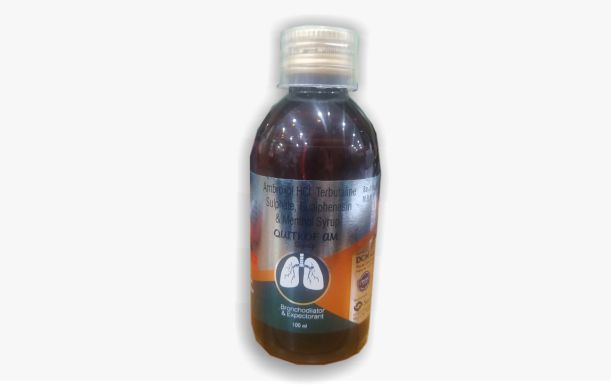
Composition
- Each 5 ml contains:
- Ambroxol HCL IP 15 mg
- Terbutaline Sulphate IP 1.25 mg
- Guaiphenesin IP 50 mg
- Menthol IP 2.5 mg
Packing
- 100 ml
Bottle
MRP
- 85
Overview
Ambroxol is a secretolytic agent used in the treatment of respiratory diseases associated with viscid or excessive mucus. Terbutaline is used for the prevention and reversal of bronchospasm in patients 12 years of age and older with reversible, obstructive airway disease, as well as symptomatic management of reversible bronchospasm associated with bronchitis and emphysema. Guaifenesin elicits an action to facilitate productive cough to manage chest congestion. Menthol mediates anesthetic properties and anti-irritating properties locally, thus it is widely used to relieve minor throat irritations.
Indications
- Cough
- Asthma
- Chest Tightness
Mechanism of actions
Ambroxol is a mucolytic agent. Nitric oxide enhances the activation of soluble guanylate cyclase and cGMP accumulation. Ambroxol has been shown to inhibit the NO-dependent activation of soluble guanylate cyclase. Inhibition of NO-dependent activation of soluble guanylate cyclase can suppress the excessive mucus secretion.
Guaiphenesin is categorized as an expectorant that acts by enhancing the output of phlegm (sputum) and bronchial secretions via decreasing the adhesiveness and surface tension of such material. It may also act as an irritant to gastric vagal receptors, and recruit efferent parasympathetic reflexes that can elicit glandular exocytosis that is comprised of a less viscous mucus mixture.
Menthol primarily activates the cold-sensitive TRPM8 receptors in the skin. Menthol, after topical application, causes a feeling of coolness due to stimulation of 'cold' receptors by inhibiting Ca++ currents of neuronal membranes. It may also yield analgesic properties via kappa-opioid receptor agonism.
Terbutaline is a relatively selective beta2-adrenergic bronchodilator that has little or no effect on alpha-adrenergic receptors. Terbutaline appears to have a greater stimulating effect on beta-receptors of the bronchial, vascular, and uterine smooth muscles (beta2 receptors) than on the beta-receptors of the heart (beta1 receptors). This drug relaxes smooth muscle and inhibits uterine contractions, but may also cause some cardiostimulatory effects and CNS stimulation.
Pharmacokinetics
Ambroxol is rapidly and completely absorbed from GIT. It shows 90% plasma protein binding and the half-life is 7-12 hours.
Guaiphenesin is well orally absorbed and volume of distribution is 116L. It is metabolised in liver and is excreted in urine. The half-life is approximately 1 hour.
Menthol primarily activates the cold-sensitive TRPM8 receptors in the skin. Menthol, after topical application, causes a feeling of coolness due to stimulation of 'cold' receptors by inhibiting Ca++ currents of neuronal membranes. It may also yield analgesic properties via kappa-opioid receptor agonism.
Terbutaline is a relatively selective beta2-adrenergic bronchodilator that has little or no effect on alpha-adrenergic receptors. Terbutaline appears to have a greater stimulating effect on beta-receptors of the bronchial, vascular, and uterine smooth muscles (beta2 receptors) than on the beta-receptors of the heart (beta1 receptors). This drug relaxes smooth muscle and inhibits uterine contractions, but may also cause some cardiostimulatory effects and CNS stimulation.
Side Effects
Common side effect of the combination includes:
- Stomach upset
- Decreased appetite
- Severe nausea
- Vomiting
- Dizziness or headache
- Rash
Precaution
Carefully use this combination in the following condition and inform your physician priorly:
- Arrhythmias
- Hyperthyroidism
- Hypertension
- Diabetes
- Myocardial insufficiency
- History of seizures
- Heart disease
Contraindication
Not be administered in patients with hypersensitive to sympathomimetic amines
Interaction
Guaiphenesin may interact with duloxetine, phenylephrine and albuterol.
Terbutaline may interact with beta-blockers, such as atenolol, carteolol, labetalol, metoprolol, nadolol, propranolol, sotalol, carvedilol, timolol and certain diuretics.